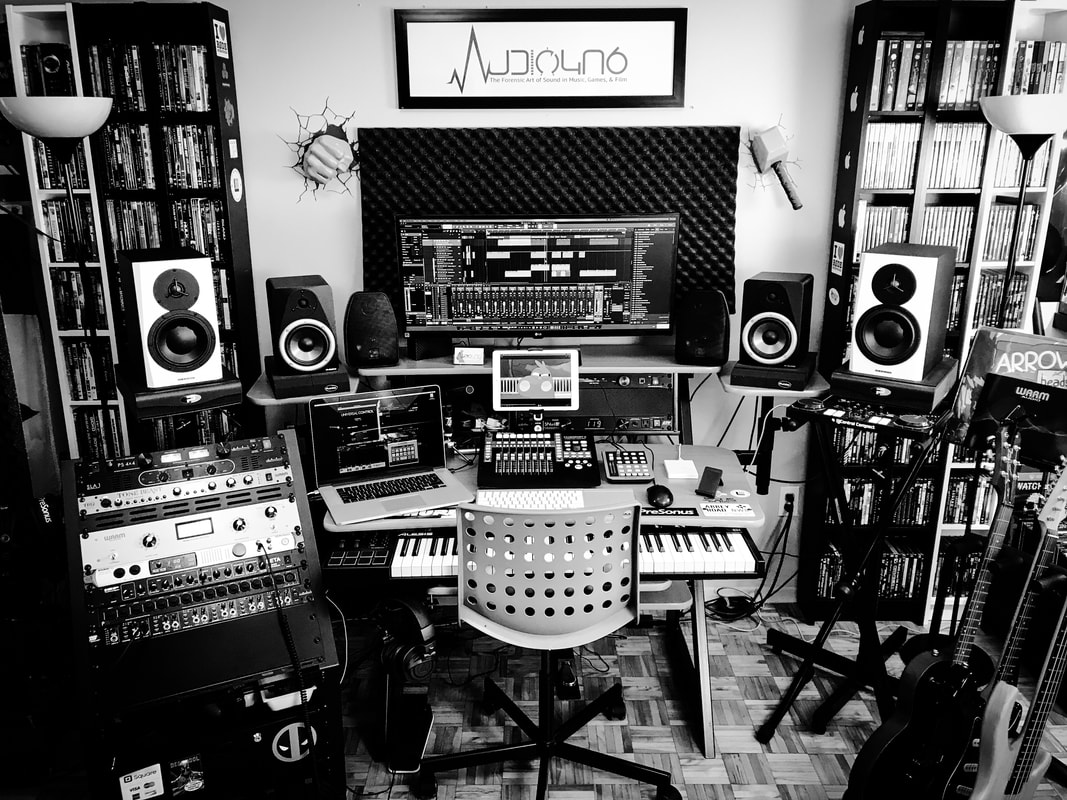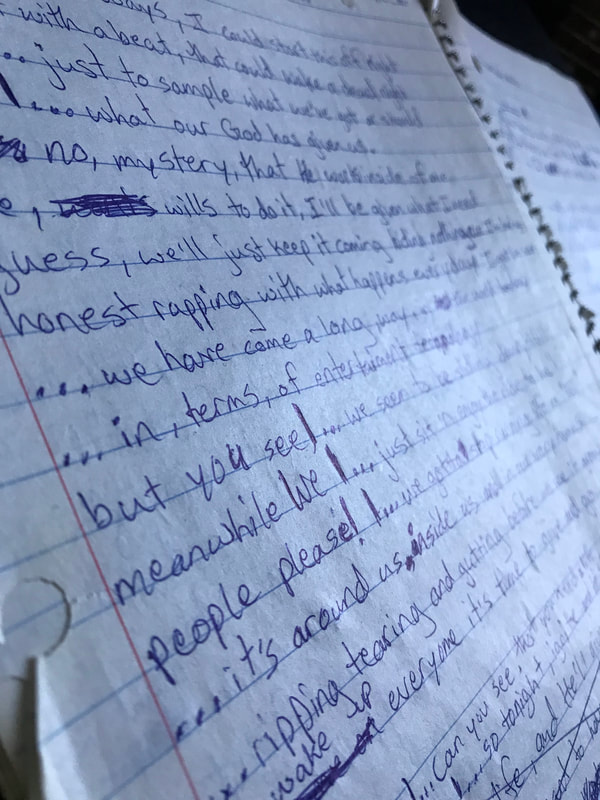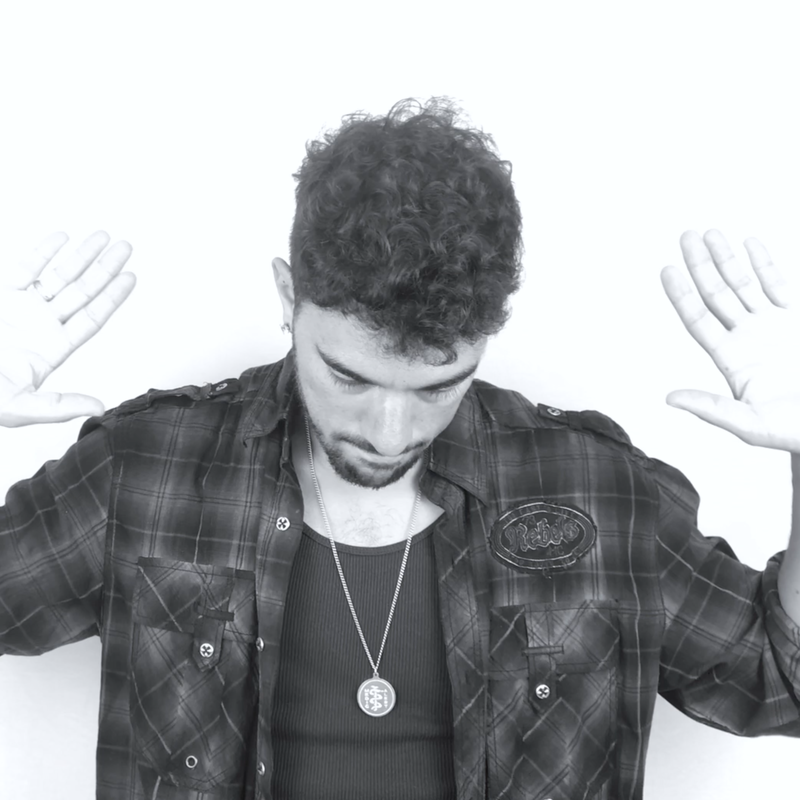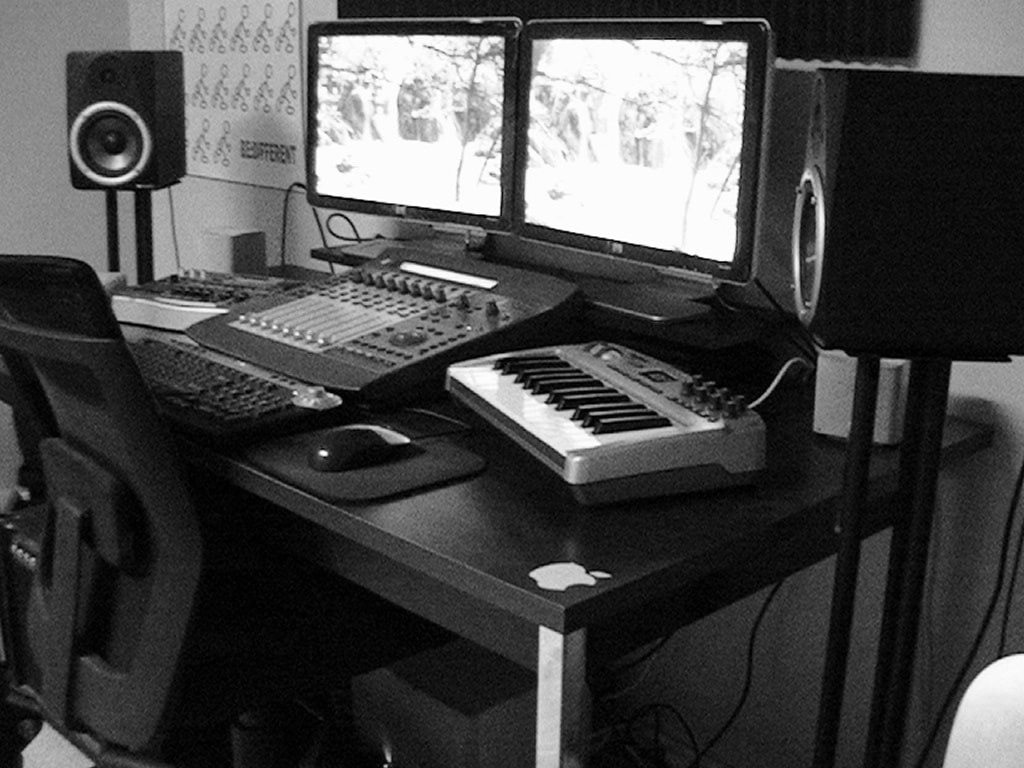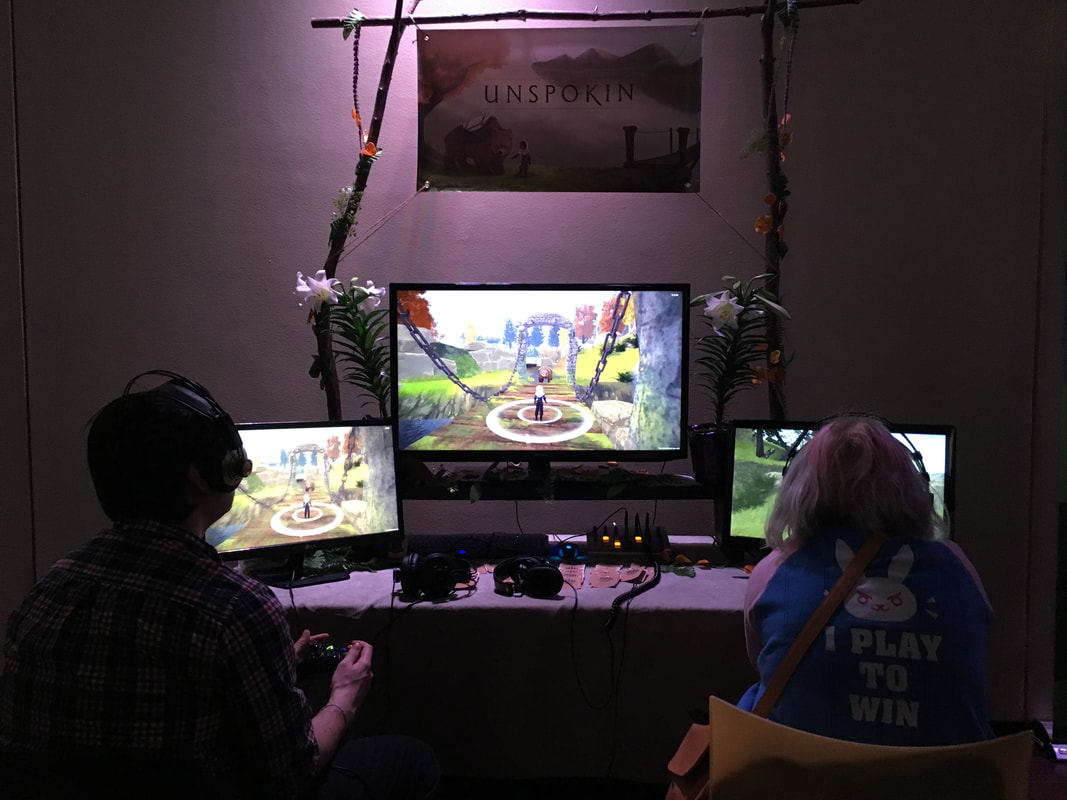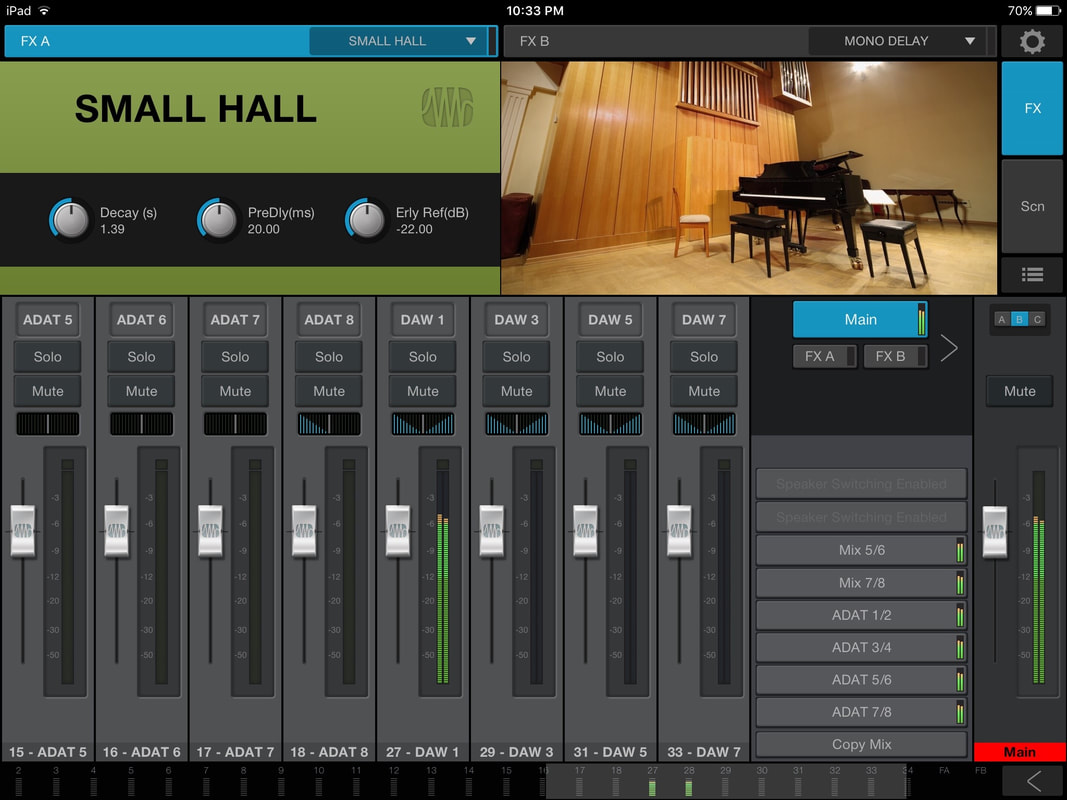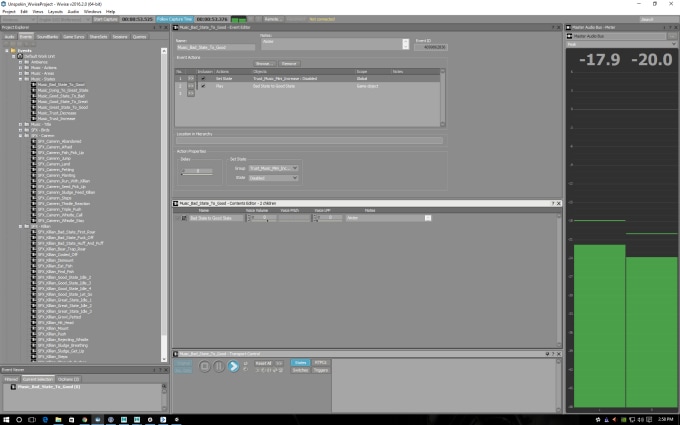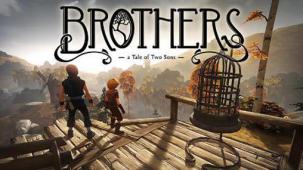It was around the age of 18 that I started messing around with music making. At first it was a private hobby as well, but years later I actually wanted to treat it like work, producing and recording for my own clients. I think this was largely fuelled by 'the recording studio experience' which I pretty much fell in love with once I got my own first taste. While drawing was wildly inventive and rewarding, I needed a different kind of broader stimulation in order to enjoy my craft long-term, especially in a professional work environment.
Anyways, while attending Sheridan College for my Bachelor of Game Design degree, I shared an elective class (Intro to Short Story) with a ton of animation students. It was there that I befriended some great talent who would eventually need composers for future projects. One day my name came up in one of their meetings and we arranged to meet while I pitched my candidacy to a group that already had access to free composers through a Sheridan / UofT collaboration. That's right, I had to sell my paid, never-composed-for-a-film-before services to a group who had access to a plethora of free, film-based composer students from the University of Toronto. Yikes. Well, I must have smelled good that day because I convinced them to take a chance on me and the rest is history. Because of half the group becoming repeat clients and their generous referrals, I eventually totalled 10 awesome animation short film projects!
Each film was very different, so I got to create some very different things and learned a ton of stuff along the way. Plus, I got to record some fun dialogue. One thing I've learned over the years is that working with others in my studio tends to produce a lot of vulnerability and a lot of laughter; both of which I think are essential for yielding great results!
There is so much understanding and intention being displayed in even the smallest movements. Every time I make a soundscape that highlights those things the way my client (the expert) intends, it warms the part of me that used to want to draw such things. One day I'll take my time again and draw something amazing, but I'm happy with my audio profession. These films brought about results in me that I would have never otherwise produced without these collaborations. In fact, I was so proud of these films that I had to release them as a soundtrack which is OUT NOW on all platforms!!!
The beautiful album cover was created by Chayadol Lomtong, a.k.a. "Dol" - creator of "The Golden Ice Cream" short film! It's a unique and colourful collage of some of the characters and themes in the films. It was a combination of his naturally inspired concepts and my poorly-explained vision. In fact, Dol had no idea what I was talking about when I first tried to explain it! But, when I better explained what I meant by things like "Golden ice cream sun... rainbow water... headphone boat... and musical note fish", he got it right away and went beyond my expectations!
1 Comment
Check out this podcast with Armand Mech, Eirik Murbraech, and myself as we discuss forgettable functional vs. memorable functional sound design, breaking into the industry, mental health, and changing the world through games!
Take a closer listen to the how and why of my creative choices when composing the music for Oddbird Studio's award-winning game, "Arrow Heads"
Arrow Heads the game is available NOW on Steam! The Arrow Heads Original Soundtrack is available NOW in 30+ digital music stores worldwide! iTunes | Spotify Arrow Heads (Original Soundtrack) 1) Camp Fire Arrows 2) A Blue Bird Bath 3) Arrow Forge 4) Bear House 5) An Oddbird Christmas 6) Sky Fall 7) Avian Ruins 8) Summit 9) Player Lobby 10) Pirate Ship 11) Cliffside 12) El Pollo 13) Factory 14) Beach 15) Post-Match Lobby 16) Birds Of A Feather (feat. The Oddbird Team, Seb, Blue Bird) After a 7-month labour of love (and frustration), it feels great to sit back and talk about our game, especially as people are now downloading, experiencing, and reviewing what we've put a lot of thought and work into. Even though we managed to create a reasonably big world with approx. 1hr of gameplay, I feel like the development of this game produced more lessons for us than actual content. It makes me want to make a hundred more games, and it makes me wish I had done a hundred things differently. I'm anxious to apply what we've learned primarily because I want to see what improved thinking and a more efficient workflow will enable me to create. I love that our game is connecting with people on a personal level - that was our ultimate goal, and it feels incredible to get here!
"Unspokin" can be downloaded for FREE on Itch.io! https://5horsemengames.itch.io/unspokin Wwisdom The majority of my time since my last blog has been dedicated to learning and using Audio Kinetic's Wwise software. Before diving into it, my only impression of middleware was of FMod - something I used briefly during our Sound Design course in 2nd year. I appreciated what it was offering the sound designer, which was essentially less dependency on code and the programmer, but I wasn't as enthralled by it as I felt I was supposed to be. FMod tries to look very much like a DAW (Digital Audio Workstation), which is definitely something I identify with, since that is a standard audio software design. However, it's precisely because of that design that I found it difficult to make logical connections between FMod and the code within Unity. Wwise I found easier to learn because I can connect the dots from audio file, to event, to event actions, to sound bank, to script event, to functionality. Within Wwise I've steadily taken more work off the programmer's hands (i.e. state changes, switches, parameters, etc.), and I can test, troubleshoot, and create a more efficient sound design all within the middleware. Wwise has a great debugging mode that provides comprehensive real-time data during gameplay so that I can observe and track every morsel of activity and burden on memory. Wwise tutorials on the Audio Kinetic website and on YouTube have been very easy to follow. The more I understand Wwise, the more I like it. I don't want to work on another game project without it in fact - I would instantly feel powerless if I did. It's through this learning experience that I've also seen how much I could have benefited from learning Wwise much earlier on. Since I'm acquiring more control over the implementation of sound and its various conditions in a 3D game world, it has become very clear how many bugs audio can have. So far, there are 95 different sound effects and music pieces in the game, and more are coming - not a single one hasn't needed adjusting in some noticeable way. Most of them don't work as intended right off the bat, especially when there are conditions (i.e. only playing a sound during a certain animation, but stopping it if the animation is interrupted by only certain actions, without it interfering with other sounds that need to carry on). It's been lots of confusing frowns on my part, but it's also been incredibly rewarding to figure these things out. I almost enjoy problem-solving within Wwise - it feels like my sound stage. I want to keep developing my Wwisdom in audio implementation so that I can see more and more of any game scene as the production window of my DAW - a tool only limited by my knowledge and imagination. I'm very excited about our game nearing completion. While the game wet set out to make isn't necessarily what we've got, I think the game we have is certainly one we want to make. The learning has been profound, and I am very anxious for more long-term game projects because I really don't see myself getting tired of development.
All About The Relationship Because of its mirroring qualities to our game, we as a team played The Last Guardian; it was an interesting play. Overall it was an impressive game and certain routes the developers took with mechanics and narrative really validated some similar routes we naturally took with ours. I also noticed how infrequent the music was, but when it did play it was for milestone type progression, and I felt that was very effective.
Initially, I considered background music during our gameplay, but The Last Guardian made me doubt that approach. I started composing the short music pieces to cue the different state changes of Killian. The music ended up feeling far better than what I had in mind for background music, and would be most effective if of course, it is only played when necessary as opposed to something on-going in the background. It then occurred to me that because the heart of our gameplay is the trust-based relationship between Cairenn and Killian, that whatever sound and music helps emphasize that would be best. With that being said, on-going background music (even if more periodic) would become more about the environment and scenery perhaps, rather than the relationship. There will already be a lot of dynamic and specific sounds for the various aspects of the relationship actions and moods, so allowing that to have its audible space to breathe I think would be most effective. We want the trust-based relationship to be the core gameplay, and rich enough that it could be enjoyed regardless of the setting. In order to stay true to that, I need to ensure the sounds of the relationship are also rich enough so that they can be enjoyed regardless of whether there is music playing or not. If I can achieve that, then the carefully selected and brief music pieces I do implement will just be icing on the audio cake. EUREKA!
After approximately 14 attempts at our game's theme music, I was finally able to find the sound it needed to be, and it got me pumped enough to shout "Eureka!" (in my head). If I were working at my home studio I would have just shouted. Not surprisingly, the breakthrough had to do with our design needing to be more fleshed out. Identifying with an existing and trending market was suggested to us by our stakeholders, so we steered our existing nature narrative toward the issue of deforestation. This allowed us to give more specific intention to our level design, character backgrounds, and plot. Much to my delight, this also made one of my theme song concepts immediately more fitting; it was already taking on an impression of going from beautiful to not so beautiful (much like the impact of deforestation on our environment and living conditions). So, I reworked the music more intentionally with that in mind, and voila; it finally sounded right! It was no longer a somewhat aimless exploration of instrumentation. I now knew the theme song; what it needed and what it didn't need. The fitting possibilities were flowing. Another aspect I was wanting to implement was now more easy to envision; audible impressions of the main characters. I wanted something to mimic characteristics of our bear and young girl; now I know what those can be, and having begun their implementations already is sounding very promising. I'm excited to finish and refine it in the coming week, such that it truly becomes the custom music identifier of everything our game is. The following screenshot shows the original theme song on the left half of the center window, and the reworked version on the right half. I shared the same instruments and most of the same patterns to ensure I wouldn't lose the uniqueness of the original, and then I dropped or changed what wasn't catering to the new focus. Once that was done, I was able to add newer elements that really enhanced the core concept that was finally sounding right. The song is called "Intrusion". What Is The Core of Our Game? It became apparent to our group that our design was missing something significant - something central. Through hearing development stories of other student groups, and after receiving feedback from classmates, we decided to address the concern of not having a core mechanic and not having done proper paper-prototyping. We were putting a lot of design thought into how puzzles would work with a player and their companion, but we didn't have a foundation or central concept to ground those things and tie it all together. We took more than a day, slaved over the concern, and came up with a solution that has not only put our worries to rest, but has also inadvertently solved other miscellaneous problems we were having. The solution was a trust-based relationship system between the player and their companion. The young mute Cairenn and her blind companion bear Killian can accomplish amazing tasks together, but the trust they establish will make or break that success. Without sight, Killian depends heavily on Cairenn to guide him considerately; if she doesn't, it will damage their bond and influence their progress, abilities, and the world around them. While embarking on a journey together, the quest between them will decide everything. Killian will have a trust meter with three states: bad, good, and great. The most common gameplay aims to be the "good" state; this is also the state with the largest meter range. In this state Killian partially trusts Cairenn which makes for moderate obedience of commands. If Cairenn tells him to stay, he may wander off. Killian's wander can lead him to follow the smell of food, uncover narrative elements, or get caught in harmful traps. If Cairenn doesn't help him avoid those traps, he will lose some trust in her and the trust meter will go down a bit. If enough misguidance causes the meter to dip into the "bad" state, Killian will lose his temper and roar. Cairenn will have to stay out of his designated roar radius to allow him to cool down on his own. Once he stops roaring, she can pet him to bring the meter back into the bottom of the "good" state. The more positive guidance Cairenn gives Killian (e.g. leading him to food and avoiding traps), the more likely the meter will move into the "great" state. In this state, Cairenn has earned Killian's trust so much that he won't wander and get into trouble if she tells him to stay. They can also complete tasks more efficiently in this state. There are other details we plan to implement for this system but that is the general idea. This has provided a number of solutions for us: - We have a core mechanic that is appealing, meaningful, and easily explained ("trust") - We have a system that level and puzzle design can be more easily developed to - We have increased replay value without needing to multiply companions and workload - Killian is now a meaningful personality with consequences and not just a tool - We have reduced the amount of required and/or expected one-off assets and designs - We have more defined boundaries now that designs can spring from the trust system - Our whole team feels more confident and excited about our game - Our whole team feels better about our scope We're finding that questions are easier to address now and this has turned a lot of redoing into a lot of refining. I have also spent some time composing some music concepts. I have 8 different compositions so far. Most of my references are Celtic, but I also wanted to embed some futurism because of the narrative's hidden portrayal of an advanced civilization and future time period. I researched some ancient Celtic instruments like the bone flute, carnyx, and crotals. I have some musical references I've found to be somewhat fitting for our game's look and feel. I've also noted keywords and phrases that depict the theme of our game and the personalities of our characters. I also use our artists' concepts for visual inspiration and guidance. It's a huge aid for me to see our characters and the environments they might inhabit as I conceive the soundtrack to their lives and ultimately, their world.
I'm taking all these things into consideration as I carefully select and customize instruments to establish potential audio palettes for the game's music. After several attempts, there are elements that seem to work well, and others not so well. I take the parts that work well and see if they can become something more in a second attempt if I strip away the parts that don't work. Eventually it seemed like the music wasn't representing enough of the narrative and characters - something was missing. I did some more research and came across African choirs. They seemed to represent the details I was missing. This is the current breakdown of styles I'm trying to combine: 50% Celtic (for mythical, festive, merry, bright, hills and valleys) 30% African (for earthy, tribal, village, bare hands, community, plains, jungle, huts) 20% Mechanical Futurism (for sophisticated tech, propulsion, turbines) I'm going to keep composing and refining my approach until it all fits in a representative and impacting way.
Challenge 1: Multiple companion choices meant multiple versions of the game It's no exaggeration to say that the original ambition of 3 companions would be triple the project work. We all knew our project scope should always be factored in, but it was felt by some that being able to choose a companion was the heart of the game. We had many meetings where we tried to find alternatives (i.e. planning for 3 but creating 1). After much deliberation and a great concern for our scope, we agreed to only do one companion and reintegrate a strong sense of choice and companion-bonding through the options and consequences of controlling your one companion. Challenge 2: Narrative-driven vs. companion driven It was challenging to blend a strong, linear narrative with puzzle-based companion gameplay. Typically, a puzzle pauses the flow of a narrative, but we wanted to dress up simpler puzzles with layers of narrative to minimize the complication of designing puzzles that weren't too hard or too easy. This would also drive the narrative more powerfully and more consistently. There were many instances however, of the puzzle dominating the narrative. As we fleshed out the puzzle mechanics - how they would work with input and a companion, and make sense in our particular game world - we learned that having it make sense from every logical angle made it overly complicated to design. Here is an example: This isn't to say that figuring it out wasn't possible, but possible within our scope for making a prototype, or even creating our vertical slice? Perhaps not. So we agreed to chop it back down again to its most basic form; player brings companion to general "push down trigger zone", player pushes a button, companion pushes over a tree object. And then, figure out how to implement the tried and true "Teach, Test, and Challenge" approach, which we eventually accomplished. Next, the goal will be to add as many narrative layers as possible to it so that the player wouldn't notice or care that the push-down animation has a bit of a "snap to", or that the blind bear wouldn't have known to turn an extra 30 degrees to push the tree down from the right angle after you commanded "push down", or that the puzzle isn't incredibly hard or incredibly easy, etc. If anything, the goal is to make the puzzle a means of following and experiencing the story.
Challenge 3: Flying Too Close I was concerned that we would be flying too close to some of our references, namely "Brothers - A Tale of Two Sons". Brothers is beautiful and has an interesting gameplay that requires both characters to be controlled with respective joysticks on the same controller. Together, they solve environmental puzzles in order to save their father.
Our game is intended to be beautiful and have an interesting gameplay where the player controls their companion uniquely and together they solve environmental puzzles in order to find the player's father. Even the art styles might end up mimicking too much. However, after learning the goal of thirds for game development (1/3 = what's already out there, 1/3 = make something about that better, 1/3 = do something innovative), I'm starting to think we're actually on the right track. We need to make sure that a huge chunk of our game is something that is already suitable for the public in terms of content and functionality; I think we are doing that. We also need to make sure that we're improving upon something in that mimicked 1/3; I think we are doing that with a simpler, yet stronger narrative-driven type of player control. Lastly, we need to be innovative which I think will naturally form. It feels like our current state is setting the stage for innovation, but we need to figure out some more things before we get there.
It Was Great, At First
I didn't even consider making music until I was about 18 years old, so my entire journey has always felt like I'm catching up - to what? The 10-year old me who could have hit the ground running I suppose. Regardless, it's only too late when you're dead, so here I am, loving and learning. After about 4 years of Fruity Loops, a Sound Technology program exposed me to Pro Tools (version 6 then) and after a month I bought it bundled with the Mbox 2 and started recording for clients. It was common knowledge that it was an "industry standard", so if it was good enough for multi-million dollar studios around the world, surely it was good enough for my bodacious bedroom setup. It was certainly a professional step up - its look and capabilities made me feel more like a pro. Particularly, my favourite aspect of it was its editing workflow.
A Pro Tools 'Pro'
Anyone whose had to "clean up" audio, do vocal compilations, fix strange anomalies, etc., would know how valuable a good editing workflow is. Tedious editing is one of the many reasons workers at the helm grind out a task non-stop, only to find they've finished it on a different day than they started. There have been times that after a long editing session I've had to spend about 10 minutes wandering around my room looking for clues as to the date, time and all the surrounding events I've missed. Some DAWs make you feel like you're serving a life sentence in post-production, and each time you come out of that workflow prison you have to adjust to the world that hasn't waited for you. Suddenly, you're being re-introduced to things like showers, hot meals and other non-waveform humanoids - the luxuries you didn't have while serving your time in solitary confinement. Granted, I'm exaggerating (not really), but you get the idea. Pro Tools had a handful of other pluses, but my hangups were steadily outweighing them more and more.
High End, High Neglect
Pro Tools was designed for top tier commercial use and in that context it has pleased many users and produced many great works. However, when they targeted the smaller, home-studio market, it quickly became clear that said market was not their expertise or priority. All these years later in 2016, I still feel like that's the case. Their time, energy and passion continue to pour into the high end user, and the rest of us tend to get the left-overs. They release more high end products, tools and features, have a support system designed for big industry (requiring a fee), and continue to do strange things like release a new line of Mbox interfaces (that were actually quite good), and then discontinue them soon after. I purchased the 3rd Generation Mbox Pro shortly after it was released and by the time I wanted to sell it and get something better suited for my needs, the value had dropped so low that it made just as little sense to sell it as it did to keep it. That's an in-between I hate being in. I've also watched Avid's Pro Tools announcements at NAMM and for the most part I've always felt like I'm not supposed to be in that crowd - too often the content doesn't apply to me. Multimedia Mess When Avid acquired Digidesign, it seemed like an okay idea - everything under one powerhouse of a roof. But I just found myself lost in the heap of things, especially their website. I needed multiple accounts and logins and when they tried to conslidate things, it still confused the hell out of me. There were too many links, too many categories, too many products, too many services, too many different GUIs and layouts, etc. There was such a lack of harmony. I remember many times doing everything I could to avoid needing to go into that website and when I had no choice, it was always a pain. Personally, I judge a company a great deal by their website. To me, a website is a company's most important asset. It is your 24/7, primary advertiser, customer service representative, and even retailer for many. Most customers these days will only know a company through their website - all their dealings from start to finish will be through those internet pages. Thus, the personality, care and attentiveness of a site in relation to its users, is paramount. Avid failed me in this regard for years.
Those are the main reasons why after a decade with Pro Tools, I was aching for something better. So, my search began. Because I had tried some other DAWs in the past, looking back into them was a quicker decision. If I saw that old hangups still existed, I moved on. It wasn't really worth crossing over unless the change was big and inspiring. Some demos I couldn't even sample for more than 5 minutes because in all honesty, many DAWs over the years have just tried to mimic Pro Tools, and that was the vibe I was still getting. I wanted to get away from that. I wanted something that worked great, looked great, inspired me and cared about me as a customer and a creator.
Enter Studio One I had come across Studio One years ago in their first version, but never tried it because of the look - I figured it was probably no different than Pro Tools, and it was a brand new DAW as well, so how could it compete with an industry veteran like Pro Tools? Well, in this new search I came across it again literally a few days before they were about to release Studio One 3, which they were hailing as "The New Standard". I'd be lying if I said I wasn't intrigued by that slogan alone, because "the standard" I had known up to that point was the source of my anguish, so a "new standard" was exactly what I was looking for. That line along with a screenshot of its completely redesigned look had me frozen like a Pro Tools glitch. I stared at that screenshot and immediately felt a surge of enthusiasm and interest. I was being inspired in a way I hadn't experienced in a decade and it was solely because of this one gorgeous and promising picture:
I was immensely curious, so I read PreSonus' website, I watched the videos, and sure enough my interest was peaking more and more. I had to download it and try (thankfully for free). Now, this is no lie - once it started up and showed me the startup page (example below), my mind was made up.
After one minute in that startup page, PreSonus catered to my most important need - the need to be cared about as a customer and a creator. That attractive startup page enables a user to not just setup their session, but also establish their identity within the program. This is something I never had before - an identity within my DAW. What this was saying to me, was that PreSonus wanted Studio One to revolve around its user, whoever they may be. I always felt that Pro Tools was designed to revolve around the rich and privileged, and in the ways Avid wanted. I am more likely to trust a company that says "Come in, have a seat, what's your name? Can I get anything for you? Here's a sample on the house. Tell us how we can do things better", and not a company that says, "Come in but don't sit down. Our name is more important than your name, and I can only help you if you pay me". I soaked in that startup page and enjoyed thinking of what it would mean for the actual workflow.
Their website reflects all these same qualities - everything from presentation to my own user account experience. Licenses are easy to transfer or remove (Avid couldn't have made that more complicated when I needed that done), it has the same personality and flow as Studio One, everything I need is there and clear, and everything I don't need isn't there. There's no noise - not with their website, software or hardware ;-). I'm confident in saying my raw audio and mixes even sound better in Studio One.
|







